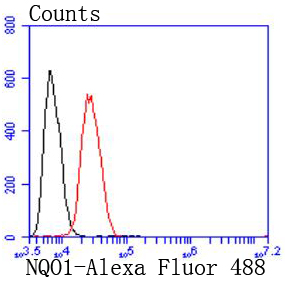Product Detail
Product NameNQO1 Rabbit mAb
Clone No.JF440-1
Host SpeciesRecombinant Rabbit
Clonality Monoclonal
PurificationProA affinity purified
ApplicationsWB, ICC/IF, IP, FC
Species ReactivityHu, Ms, Rt
Immunogen Descrecombinant protein
ConjugateUnconjugated
Other NamesAzoreductase antibody Cytochrome b 5 reductase antibody DHQU antibody DIA 4 antibody DIA4 antibody Diaphorase (NADH/NADPH) (cytochrome b 5 reductase) antibody Diaphorase (NADH/NADPH) antibody Diaphorase 4 antibody Dioxin inducible 1 antibody DT diaphorase antibody DT-diaphorase antibody DTD antibody Menadione reductase antibody NAD(P)H dehydrogenase [quinone] 1 antibody NAD(P)H dehydrogenase quinone 1 antibody NAD(P)H menadione oxidoreductase 1 dioxin inducible antibody NAD(P)H: menadione oxidoreductase 1 dioxin inducible 1 antibody NAD(P)H:menadione oxidoreductase 1 antibody NAD(P)H:Quinone acceptor oxidoreductase type 1 antibody NAD(P)H:quinone oxidoreductase 1 antibody NAD(P)H:quinone oxireductase antibody NMOR 1 antibody NMOR I antibody NMOR1 antibody NMORI antibody NQO 1 antibody NQO1 antibody NQO1_HUMAN antibody Phylloquinone reductase antibody QR 1 antibody QR1 antibody Quinone reductase 1 antibody
Accession NoSwiss-Prot#:P15559
Uniprot
P15559
Gene ID
1728;
Calculated MW31/27 kDa
Formulation1*TBS (pH7.4), 1%BSA, 40%Glycerol. Preservative: 0.05% Sodium Azide.
StorageStore at -20˚C
Application Details
WB: 1:1,000-5,000
ICC: 1:50-1:200
IP: 1:50
FC: 1:50-1:100
Western blot analysis of NQO1 on different lysates using anti-NQO1 antibody at 1/1,000 dilution. Positive control: Lane 1: SH-SY-5Y Lane 2: Mouse kidney Lane 3: Raji
Flow cytometric analysis of Hela cells with NQO1 antibody at 1/50 dilution (red) compared with an unlabelled control (cells without incubation with primary antibody; black). Alexa Fluor 488-conjugated goat anti rabbit IgG was used as the secondary antibody
NAD(P)H:quinone oxidoreductase 1 (NQO1) and NRH:quinone oxidoreductase (NQO2) are flavoproteins that catalyze the metabolic detoxification of quinones and their derivatives to hydroquinones, using either NADH or NADPH as the electron donor. This protects cells against quinone-induced oxidative stress, cytotoxicity, and mutagenicity. Many tumors overexpress NQO1, which is an obligate two-electron reductase that deactivates toxins and activates bioreductive anticancer drugs. NQO1, a 274 amino acid protein, is ubiquitously expressed, but the expression level varies among tissues. NQO1 gene expression is coordinately induced in response to xenobiotics, antioxidants, heavy metals and radiation. The antioxidant response element (ARE) in the NQO1 gene promoter is essential for expression and coordinated induction of NQO1. ARE activation by tert-butylhydroquinone is dependent on PI3-kinase, which lies upstream of Nrf2. Nrf2, c-Jun, Nrf1, Jun-B and Jun-D bind to the ARE and regulate expression and induction of NQO1 gene. Maf-Maf homodimers and possibly Maf-Nrf2 heterodimers play a role in negative regulation of ARE-mediated transcription, but Maf-Nrf1 heterodimers fail to bind with the NQO1 gene ARE and do not repress NQO1 transcription.
If you have published an article using product 49364, please notify us so that we can cite your literature.
et al,Asperuloside suppressing oxidative stress and inflammation in DSS-induced chronic colitis and RAW 264.7 macrophages via Nrf2/HO-1 and NF-kB pathways. In Chem Biol Interact on 2021 Aug 1 by Yong-Er Chen , Shi-Jie Xu et al..PMID:33974900, , (2021), , , (2021)
, (2021),
PMID:
33974900
et al,Dictamnine alleviates DSS-induced colitis mice by inhibiting ferroptosis of enterocytes via activating Nrf2-Gpx4 signaling pathway.
, (2025),
PMID:
40049578




 Yes
Yes



